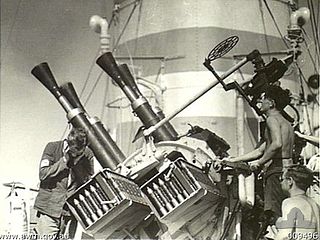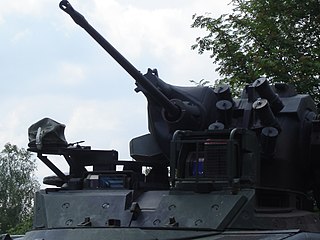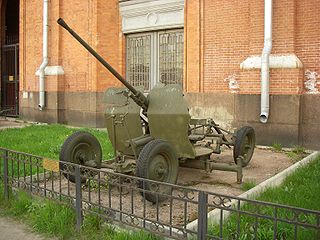
An autocannon, automatic cannon or machine cannon is a fully automatic gun that is capable of rapid-firing large-caliber armour-piercing, explosive or incendiary shells, as opposed to the smaller-caliber kinetic projectiles (bullets) fired by a machine gun. Autocannons have a longer effective range and greater terminal performance than machine guns, due to the use of larger/heavier munitions, but are usually smaller than tank guns, howitzers, field guns, or other artillery. When used on its own, the word "autocannon" typically indicates a non-rotary weapon with a single barrel. When multiple rotating barrels are involved, such a weapon is referred to as a "rotary autocannon" or occasionally "rotary cannon", for short.

The Bofors 40 mm Automatic Gun L/60 is an anti-aircraft autocannon, designed in the 1930s by the Swedish arms manufacturer AB Bofors. The gun was designed as an intermediate anti-aircraft gun, filling the gap between fast firing close-range small calibre anti-aircraft guns and slower firing long-range high calibre anti-aircraft guns. The Bofors 40 mm L/60 was for its time perfectly suited for this role and outperformed competing designs in the years leading up to World War II in both effectiveness and reliability.

The AK-230 is a Soviet fully automatic naval twin 30 mm gun. Its primary function is anti-aircraft. It is mounted in an enclosed automatic turret and directed by radar. AK-230 is widely used, mounted on big warships as well as small craft. About 1450 guns were produced in the USSR, and about 300 were produced in China as the Type 69. It was succeeded by the more powerful AK-630 from the mid-to-late 1970s.

The ZU-23-2, also known as ZU-23, is a Soviet towed 23×152mm anti-aircraft twin-barreled autocannon. ZU stands for Zenitnaya Ustanovka – anti-aircraft mount. The GRAU index is 2A13.

The ZSU-57-2 Ob'yekt 500 is a Soviet self-propelled anti-aircraft gun (SPAAG), armed with two 57 mm autocannons. 'ZSU' stands for Zenitnaya Samokhodnaya Ustanovka, meaning "anti-aircraft self-propelled mount", '57' stands for the bore of the armament in millimetres and '2' stands for the number of gun barrels. It was the first Soviet mass-produced tracked SPAAG. In the USSR, it had the unofficial nickname Sparka, meaning "twin mount," referring to the twin autocannon with which the vehicle is armed.

The 2-pounder gun, officially the QF 2-pounder and universally known as the pom-pom, was a 40 mm (1.6 in) British autocannon, used as an anti-aircraft gun by the Royal Navy. The name came from the sound that the original models make when firing. This QF 2-pounder was not the same gun as the Ordnance QF 2-pounder, used by the British Army as an anti-tank gun and a tank gun, although they both fired 2 lb (0.91 kg), 40 mm (1.6 in) projectiles.

The Type 96 25 mm gun was an automatic cannon used by the Imperial Japanese Navy during World War II. A locally-built variant of the French Hotchkiss 25 mm anti-aircraft gun, it was designed as a dual-purpose weapon for use against armored vehicles and aircraft, but was primarily used as an anti-aircraft gun in fixed mounts with one to three guns.

The Oerlikon GDF or Oerlikon 35 mm twin cannon is a towed anti-aircraft gun made by Oerlikon Contraves. The system was originally designated 2 ZLA/353 ML but this was later changed to GDF-001. It was developed in the late 1950s and is used by around 30 countries.

The Rheinmetall Mk 20 Rh-202 is a 20 mm caliber autocannon designed and produced by Rheinmetall. It fires the 20×139mm ammunition originally developed for the Hispano-Suiza HS.820.

The Flak 30 and improved Flak 38 were 20 mm anti-aircraft guns used by various German forces throughout World War II. It was not only the primary German light anti-aircraft gun but by far the most numerously produced German artillery piece throughout the war. It was produced in a variety of models, notably the Flakvierling 38 which combined four Flak 38 autocannons onto a single carriage.

The M45 Quadmount was a towed anti-aircraft gun consisting of four .50 caliber M2 Browning machine guns mounted in pairs on either side of an armored open-top gunner's compartment with electrical laying. It was developed by the W. L. Maxson Corporation to replace the earlier M33 twin mount. Although designed as an anti-aircraft weapon, it was also used against ground targets, where it earned the nicknames "meat chopper" and "Krautmower" Introduced in 1944, it saw service as late as the Vietnam War.

The KPV-14.5 heavy machine gun is a Soviet designed 14.5×114mm-caliber heavy machine gun, which first entered service as an infantry weapon in 1949. In the 1960s, the infantry version was taken out of production because it was too large and heavy. It was later redesigned for anti-aircraft use, as it showed excellent results as an AA gun against low flying aircraft, with a range of 3,000 m (9,800 ft) horizontally and 2,000 m (6,600 ft) vertically. It was used in the ZPU series of anti-aircraft guns. Its size and power also made it a useful light anti-armour weapon on the BTR series of vehicles and the BRDM-2 scout car.

The 3.7 cm Flak 18/36/37 was a series of anti-aircraft guns produced by Nazi Germany that saw widespread service in the Second World War. The cannon was fully automatic and effective against aircraft flying at altitudes up to 4,200 m. The cannon was produced in both towed and self-propelled versions. Having a flexible doctrine, the Germans used their anti-aircraft pieces in ground support roles as well; 37 mm caliber guns were no exception to that. With Germany's defeat, production ceased and, overall, 37 mm caliber anti-aircraft cannon fell into gradual disuse, being replaced by the Bofors 40 mm gun and later, by 35-mm anti-aircraft pieces produced in Switzerland.

The South Korean K30 Biho twin 30 mm self-propelled anti-aircraft weapon was developed to meet the operational requirements of the Republic of Korea Armed Forces for a highly mobile short range air defense system suited to the operational and terrain conditions of the Korean peninsula. It combines an electro-optically guided 30 mm gun system with a surveillance radar system on a K200 chassis. It supplements the K263A1 Chungung, a self-propelled 20 mm Vulcan system.

The 37 mm automatic air defense gun M1939 (61-K) is a Soviet 37 mm calibre anti-aircraft gun developed during the late 1930s and used during World War II. The land-based version was replaced in Soviet service by the AZP S-60 during the 1950s. Guns of this type were successfully used throughout the Eastern Front against dive bombers and other low- and medium-altitude targets. It also had some usefulness against lightly armoured ground targets.

The MG 81 is a German belt fed 7.92×57mm Mauser machine gun which was used in flexible installations in World War II Luftwaffe aircraft, in which capacity it replaced the older drum magazine-fed MG 15.

25 mm automatic air defense gun M1940 (72-K) was a Soviet 25 mm caliber anti-aircraft gun used during the World War II. The gun was developed from the end of 1939 to the beginning of 1940 at 8th Kalinin Artillery Plant under the guidance of its Chief Designer Mikhail Loginov, supervised by Lev Loktev. The cannon was given the factory code 72-K before being accepted into service by the Red Army as the 25 mm automatic air defense gun M1940.
The Type 85 anti-aircraft artillery is a 23 mm artillery gun used by the People's Liberation Army of China. It is a copied version of the Soviet ZU-23-2.

The ZSU-23-4 "Shilka" is a lightly armored Soviet self-propelled, radar-guided anti-aircraft weapon system (SPAAG). It was superseded by the 9K22 Tunguska.

The Type 09 is a Chinese self-propelled anti-aircraft vehicle manufactured by Norinco. It is armed with two 35 millimeter cannons and optionally two to four fire-and-forget infrared homing missiles. It started to gradually replace the predecessor Type 95 in 2009. Some military analysts designated the vehicle as Type 07, but the official designation was confirmed as Type 09 on the Theme Exhibition of the 90th Anniversary of Chinese People's Liberation Army in 2017.



















